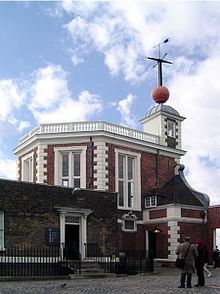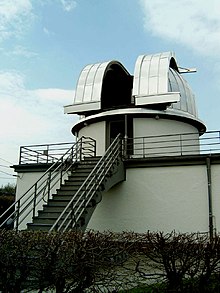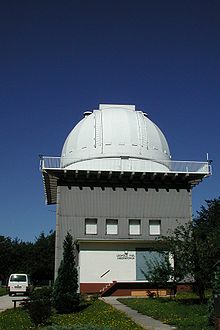Observatory


An observatory or an astronomical observatory (from Latin observare = to observe) is a place with scientific instruments for observing the starry sky . In addition to individual celestial bodies of the solar system and the Milky Way (stars, star clusters, nebulae), extragalactic celestial objects are the target of observation.
Scientific observatories are usually built on elevated locations and protected from the weather by a dome . When choosing the location, the greatest possible number of clear nights, little interfering light and little air turbulence are essential. The latter is given where (especially in the mountains) laminar air currents prevail.
In the case of observatories for educational purposes ( people's observatory ) or amateur astronomy ( private observatory ) , these requirements are less important than easy accessibility.
For observations in visible light, near infrared and UV, mirror telescopes and astrographs are predominant today, while lens telescopes (refractors) and transit instruments (for positional astronomy) are declining. In addition, there are numerous radio telescopes , which are hardly included in the term “observatory”.
Features of observatories

The appearance of today's observatories is usually characterized by one or more domes , the
- on the one hand can be opened for observation and rotated in the desired direction ,
- on the other hand, should protect the instrument placed underneath when closed,
- The light-painted dome ensures that the air is consistently cool thanks to its good reflection and insulation against solar radiation (see nocturnal cooling ). However, the remaining thermal effects cause the so-called hall refraction .
The instruments themselves (especially the telescopes) are mounted on their own pedestals that are mechanically strictly separated from the rest of the building to protect them from shocks and vibrations . For these pillars , which are deeply rooted in the natural rock , the classic, ventilated brick construction is still a mechanically and thermally good solution, while concrete is less favorable (possible temperature and internal stresses , noticeable pillar rotation ). In the case of heavy telescopes, their foundation must reach down to at least two meters in solid ground (if possible in the natural rock), with loose rock even up to 10 meters.
The modern large telescopes , which have mirrors up to 10 m in diameter and in the future even 40 m, are no longer housed in domes, but mostly in cube-shaped protective structures that are opened for use. For weight reasons, the mechanically simpler azimuthal mount is used here instead of the classic equatorial mount .
Research, public and private observatories
The term observatory includes research stations in various natural sciences such as meteorology or biology, but is also used for artificial earth satellites that carry astronomical telescopes. These satellites usually carry several instruments that can observe the same target or can be controlled separately (see satellite technology ).
Structures with a special construction that are used to observe astronomical phenomena such as the summer or winter solstice are sometimes also referred to as observatories . As solar observatories , they can often be assigned to a prehistoric culture where the course of the sun was observed (e.g. Goseck or Stonehenge circular ditches ). Modern examples are the star garden operated by the Austrian Astro Association in the south of Vienna and a similar one in the Ruhr area .
The term observatory, on the other hand, means fixed, predominantly astronomical observatories. One distinguishes
- Research observatories , which are mostly far from cities, have large instruments and a considerable number of employees. They usually belong to a university or academy and pursue national research projects or those in international cooperation. They are the main subject of the following sections.
- Public observatories , which are mainly used for public tours and adult education . Most of the time they are sponsored by astro clubs or the local community. Similar objectives pursue school Observatories . Sometimes both types are combined or are equipped with planetariums . In the latter, however, no celestial bodies are observed, but the astronomical objects are artificially projected.
- Private observatories , on the other hand, are operated by individual, mostly well-off amateur astronomers , and occasionally by associations. Some also offer star tours to the public or the neighborhood on so-called astronomy days . Many observation areas are set up on residential buildings and protected with small domes or a sliding or rolling roof . On green spaces they are called garden observatories. Less complex, but more flexible, they are designed as terrace or roof observatories , especially with portable telescopes.
Choosing the location of research observatories
The question of suitable locations became more and more important in the 19th century due to the expansion of cities. Because the light dome of large cities can often extend 50 to 100 km. The observatories, which used to be built near royal courts, were gradually relocated to sparsely populated areas or to the mountains .
In addition to the aspect of low interfering light, it is also important to choose a suitable location
- an area with a favorable climate (frequent high pressure situations, long hours of sunshine , low tendency towards storms)
- a terrain shape with even air flow, which promotes seeing (low air turbulence). So divorce z. B. many mountains with a good climate, but asymmetrical summit shapes
- rocky subsoil for a stable foundation of the instrument pillars .
- Favorable transport connections and other infrastructure are also important.
Instruments
The observations or measurements are mostly carried out with telescopes (lens telescopes or mirror telescopes ) or astrographs , now increasingly also with antenna technology (radio astronomy) or with automated transit instruments for position astronomy. Most observatories observe in visible light, with the earlier visual methods being largely replaced by photographic and optoelectronic ones.
Until about 1620 the observatories were almost exclusively set up for free-eyed observation of the sky, equipped with meridian circles or sextants, armillary spheres , gnomon or large sundials (see also Astronomical Phenomenology ). For thousands of years, astrometry (determination of star locations and movements, celestial mechanics and time determination) has dominated scientific activity , which was only supplemented (and temporarily pushed into the background) from 1850 by astrophotography and astrophysics . Today, the work of high-altitude observatories with clean and dry air (European high mountains, Hawaii, Chilean Andes) increasingly focuses on non-visual radiation areas such as near infrared , UV and radio radiation , while the shorter wavelengths (UV and X-rays ) are largely reserved for space telescopes stay. Observatories on the moon are also being planned.
history
Prehistory, antiquity and the Middle Ages
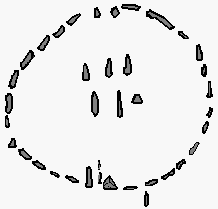
Currently the oldest dated Observatory of the history system in force is possibly the county grave system of Goseck from the 5th millennium v. Chr. The megalithic circle in Nabta Playa in the Nubian Desert could also fall into this time. Other systems date from around 3000 BC. BC ( Stonehenge ) or 1200 BC BC ( Boitin stone dance ).
The Cheomseongdae Observatory in Korea is the oldest in the Far East . China has a long tradition of building observatories. In the Tang Dynasty , 20 solar observatories were built for the creation of the Da Yan calendar 729 AD , with 10 observatories being distributed along the 114th degree east from Central Asia to Huế to check the spherical shape of the earth. The Yuan dynasty had 27 large observatories built for the Shou Shi calendar in 1281, with the Gaocheng observatory near Dengfeng in Henan Province still in good condition.
In Peru is the 2300 year old Chanquillo Observatory, which consists of 13 towers on a mountain ridge. Whether the megalithic complex in the Armenian Zorakarer is an astronomical facility is highly controversial.
The first forerunners of the "classic" observatories emerged in the late Middle Ages and the time after. They were home to instruments for measuring star words, for example quadrants or astrolabes , or large sundials . Examples are the Rasad-e Khan observatory by Nasir Al-din al-Tusi , the observatory of Ulug Beg , Uraniborg and Stjerneborg , the observatory of Tycho Brahes or the Jantar Mantars of Maharajas Jai Singh II.
Modern times
After the invention of the telescope in 1608, the first observatories in the current sense emerged in the following decades. From 1700 some belonged to physical cabinets , as they were maintained and promoted by nobles and other patrons during and after the Enlightenment . Often it was a question of extended attic storeys, attached towers or the like. Independent observatory buildings were often designed as astronomical towers , such as the Kremsmünster observatory (Upper Austria), the Prague Clementinum or the Mannheim observatory .
At the beginning of the telescope era, the Paris Observatory 1667 and the Royal Greenwich Observatory 1675 were built. The first observatory after Stjerneborg where the instruments were placed in a single-storey building was the Seeberg Observatory in Gotha, which opened in 1790 was taken. These early observatories were mainly devoted to astrometry (determination of star locations and planetary orbits) and also served as base points for navigation and land surveying .
Observatories only became accessible to the public after the construction of public observatories in the 19th century. The first school observatory in Germany was founded in Bautzen , East Saxony , in 1872 .
Many important observatories in Central and Northern Europe were founded between 1790 and 1830, including those in Hamburg-Altona, Munich, Düsseldorf, Gotha, Leipzig, Halle, Königsberg and Dorpat. Russia and the USA followed suit in 1839 with St. Petersburg-Pulkowa and Harvard. This wave of founding is mainly related to the successes of celestial mechanics (planetary orbits, comets, asteroids, double star research, star catalogs), as well as the development of measurement technology. In contrast, the university observatories in the southern half of Europe were mostly built earlier. The second founding boom can be seen at the turn of the century and brought about the development of astrophysics - see, among others, Potsdam (astrophys. Inst.), Vienna (Univ. And Kuffnersternwarte), Zurich and the large observatories in the USA such as Yerkes, Lick and Lowell. These included some private observatories that are important for research .

A sky that is as dark as possible (low light pollution ) is important for the quality of the observation . Nevertheless, until the end of the 19th century, most observatories were located near or even in cities - also to be close to the financier, generally the local royal court. For the current location, see the previous sections.
The growth of cities and the associated light pollution (light smog) , which increasingly impaired observations, led in the 20th century to a shift to increasingly remote areas that were not yet affected by light smog, such as mountains , initially closer mountains such as the Pyrenees or the Alps and finally in areas far away from larger settlements and with clear and calm air, such as on Mauna Kea in Hawaii or in the Atacama Desert in Chile .
At the same time, technological progress made it possible to manufacture ever larger telescopes that can capture ever weaker amounts of light and thus allow observations into ever greater depths of space. These instruments also reach their limits due to the natural unrest in the air . Powerful adaptive optics are able to almost completely correct this disadvantage, but usually only in very small image fields. One way out was in the construction of space telescopes that enable observations outside of the disturbing influence of the earth's atmosphere , such as the Hubble space telescope . In addition, space telescopes have been developed to enable observations in spectral ranges that are inaccessible from the ground, such as in the far infrared or in the range of X-rays .
Individual observatories and observatories
Prehistoric and early historical buildings (selection)
- Stonehenge
- Pyramids of Giza
- Goseck district moat
- Mayan solar observatories , e.g. B. on Monte Alban
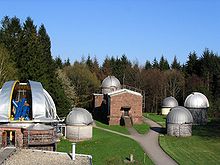

Observatories in Germany (selection)
Research institutes
- Bamberg : Dr. Remeis observatory
- Bonn : Hoher List Observatory
- Dresden : Triebenberg
- Göttingen : Göttingen University Observatory
- Hamburg : Hamburg observatory in Bergedorf
- Heidelberg : State Observatory Heidelberg-Königstuhl
- Munich : University observatory Munich
- Potsdam : Astrophysical Institute Potsdam
- Sonneberg : Sonneberg observatory
- Tautenburg : Thuringian State Observatory
Public observatories
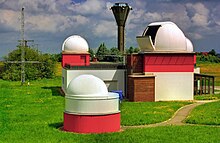
- Aachen : Volkssternwarte Aachen
- Augsburg : Diedorf observatory
- Bad Kreuznach : Bad Kreuznach public observatory
- Bad Nauheim : Volkssternwarte Wetterau
- Bad Salzuflen : Walter Baade Observatory
- Bielefeld : Ubbedissen public observatory
- Berlin : Archenhold observatory , Wilhelm Foerster observatory
- Bonn : Volkssternwarte Bonn
- Buchloe : Buchloe Public Observatory
- Darmstadt : Darmstadt public observatory
- Dieterskirchen : Public observatory with Dieterskirchen planetarium
- Dortmund : Volkssternwarte Dortmund
- Dresden : Observatories of the former Manfred von Ardenne research institute
- Ebermannstadt : Feuerstein observatory
- Ennepetal : Public observatory Ennepetal
- Erkrath : Neanderhöhe Hochdahl observatory
- Frankfurt am Main : Volkssternwarte Frankfurt of the Physical Association , Taunus Observatory
- Fulda : Hans-Nüchter-Sternwarte (public and school observatory with planetarium)
- Gilching : People's observatory at the vhs Gilching
- Hagen : Hagen public observatory
- Hanover : Volkssternwarte Hanover
- Heilbronn : Robert-Mayer-Volks- und Schulsternwarte Heilbronn
- Heppenheim : Starkenburg observatory
- Hofheim am Taunus : Hofheim observatory
- Jena : Urania Jena public observatory
- Kempten (Allgäu) : Kempten public observatory
- Cologne : Volkssternwarte Cologne
- Laupheim : Laupheim public observatory
- Limburg Observatory , Hesse
- Lübeck : Lübeck observatory
- Mainz : Volkssternwarte Mainz
- Meckesheim : Mecklenburg public observatory
- Munich : Bavarian People's Observatory Munich
- Neumarkt in the Upper Palatinate : Fritz Weithas Observatory
- Neumünster Observatory , Schleswig-Holstein
- Nuremberg : Regiomontanus observatory
- Ottobeuren : Allgäuer Volkssternwarte Ottobeuren
- Paderborn : Public observatory Paderborn
- Radebeul : Public Observatory Adolph Diesterweg
- Recklinghausen : Public observatory Recklinghausen
- Regensburg : Volkssternwarte Regensburg
- Reutlingen : Reutlingen observatory and planetarium
- Riesa : Riesa public observatory
- Rosenfeld : Zollern-Alb observatory
- Rostock : Astronomical Station "Tycho Brahe"
- Rothwesten : People's observatory Rothwesten
- Schwerin : Schwerin observatory and planetarium
- Singen (Hohentwiel) : Singen public observatory
- Sohland on the Spree : Sohland / Spree observatory
- Sankt Andreasberg : Sankt Andreasberg / Harz Observatory at the International Haus Sonnenberg
- Streitheim : Volkssternwarte and Planetarium Streitheim
- Solingen : Solingen observatory
- Tübingen : People's Observatory Tübingen
- Tirschenreuth : Gerhard-Franz Volkssternwarte
- Ursensollen : Planetarium with Ursensollen observatory
- Wertheim : Johann Kern Observatory Wertheim
- Wiesbaden : Wiesbaden observatory
- Würzburg : Volkssternwarte Würzburg
- Zweibrücken : Zweibrücken public observatory
Other observatories
- Aalen : Aalen observatory
- Bautzen : School observatory "Johannes Franz"
- Berlin : Bruno H. Bürgel Observatory
- Bernau : Bernau observatory
- Bochum : Observatory Bochum, Institute for Environment and Future Research (IUZ)
- Nohfelden (Saarland) : Peterberg observatory
- Bremen : Walter Stein Observatory
- Duisburg : Rudolf-Römer-Observatory
- Essen : Walter Hohmann Observatory
- Glücksburg : Menke observatory
- Greifswald : Greifswald observatory
- Heppenheim : Starkenburg observatory
- Heidenheim an der Brenz : Willi Hüll observatory
- Herne : Herne observatory
- Kaiserslautern : School observatory at the school center south
- Kassel : Kassel observatory
- Kiel : Kiel observatory
- Melle : Melle public observatory and Melle EXPO observatory
- Stuttgart : Stuttgart observatory
- Welzheim : Welzheim observatory
Observatories in Austria (selection)
-
Burgenland
- State Observatory Leinnerhaus
- Carinthia :
- Lower Austria
- Upper Austria
-
Salzburg
- Nußdorf am Haunsberg : Observatory of the House of Nature - 2 telescopes, opens on August 20, 2018
-
Styria
- University observatory Graz
- Graz: Lustbühel Observatory
- Kepler-Gymnasium Graz : Johannes Kepler observatory
- Thal near Graz : Johannes Kepler public observatory (Steinberg)
- Feldbach - Auersbach : Auersbachtal public observatory
- Hartberg : Observatory in the Ecopark
- Vienna
Observatories in Switzerland (selection)
Research institutes
- Bern : Zimmerwald satellite station
- Neuchâtel : Temporary service and Observatoire cantonal de Neuchâtel
- Geneva : Geneva Observatory
Private and public observatories
- Aarau : Einstein Tower, Aarau Old Canton School
- Bülach : Bülach observatory
- Falera (GR): Mirasteila's asteroid observation tower
- Ependes Observatory , Freiburg
- Rotheul observatory, Föritztal
- Planetarium and observatory Kreuzlingen
- Schwanden ob Sigriswil : Observatory - Planetarium SIRIUS
- Winterthur : Eschenberg observatory
- Zurich : Urania observatory
Historical observatories (selection)
- Altona : Altona observatory , 1823 to 1871
- Berlin : Berlin observatory , 1711 to 1913
- Bothkamp near Kiel : Bothkamp observatory , 1870 to 1914
- Düsseldorf-Altstadt : Jesuit College , approx. 1710 to 1953
- Düsseldorf-Bilk : Düsseldorf observatory , 1843 to 1943
- Gotha : Gotha observatory , 1790 to 1934 (including Seeberg observatory 1790 to 1839)
- Halle (Saale) : Halle observatory , 1788 to 1923
- Königsberg : Königsberg observatory , 1813 to 1944
- Kremsmünster (Upper Austria): Kremsmünster observatory (first high-rise), built 1749–1758
- Leipzig : Leipzig observatory , 1790 to 1956
- Lilienthal near Bremen : Lilienthal observatory , 1782 to 1850
- Mannheim : Mannheim observatory , 1774 to 1880
- Pula : Pola Marine Observatory , 1871 to 1918
- Remplin / Mecklenburg : Remplin observatory , 1793 to 1805
- Tartu ( Estonia ): Dorpat Observatory , 1811 to 1948
- Zurich : Federal Observatory , 1864 to 1980
Other observatories (selection)
- Australia : Mount Stromlo Observatory , Siding Spring Observatory
- Chile : La Silla ( ESO ), Paranal Observatory ( ESO )
- Spain : Calar Alto Observatory , Roque de los Muchachos Observatory , Observatorio del Teide
- Russia : Pulkovo Observatory , Zelenchuk Observatory
- United Kingdom : Royal Greenwich Observatory
- Ireland : Dunsink Observatory
- USA : Big Bear Solar Observatory , Kitt Peak National Observatory , Lick Observatory , Large Binocular Telescope , Mauna Kea Observatory , Mount Palomar , Mount Wilson Observatory , Yerkes Observatory
In the airspace (selection)
- Balloon-worn: Stratoscope , Sunrise , Far Infrared Interferometric Telescope
- Airborne : Lear Jet Observatory , Kuiper Airborne Observatory , SOFIA
In space (selection)
- Hubble Space Telescope ( NASA / ESA )
- Spitzer Space Telescope (NASA)
- XMM Newtonian Space Telescope (ESA)
- Chandra Space Telescope (NASA)
- James Webb Space Telescope (NASA / ESA / CSA )
Measures regarding the corona pandemic
At the beginning of the lockdown in March 2020 due to the corona virus, almost all observatories stopped their public tours. Restricted operation was only possible where there was sufficient space outdoors or very well ventilated domes.
Since the relaxation, which began in different countries in June or July, various measures have been tried out in public observatories and astro clubs [1] , [2] in particular
- Keep your distance (at least 1 to 1.5 meters) and wear a mask if necessary
- Star tours only for small or family groups
- Disinfection measures on the telescope with every change of observer
- Observation through disposable foils or only with your own instrument.
Public observatories with a larger outdoor area or astro clubs can be
- restrict to free-eyed observation, for example
- for observing constellations or in the Perse Nights in August,
- recommend that you bring your own binoculars
- or their "star parties" begin at dusk.
See also
- State observatory
- List of the largest optical telescopes
- List of planetariums in Germany
- Virtual observatory
- List of observatory codes
- Marine observatory
literature
- David Leverington: Observatories and Telescopes of Modern Times - Ground-Based Optical and Radio Astronomy Facilities since 1945. Cambridge University Press, Cambridge 2016, ISBN 978-0-521-89993-2 .
Web links
- Link catalog on the topic of public observatories at curlie.org (formerly DMOZ )
- Directory of astronomical institutes in German-speaking countries
- Directory of public observatories in German-speaking countries in the German Astronomical Directory
- Observatories in Austria austriaca.at, map and list of the OeAW (2005, supplemented in 2012)
- Milkyweb Astronomical Observatory Guide since 2001 the most extensive directory of astronomical observatories worldwide - approx. 2000 entries with profile
- Jantar Mantar - historical observatories in Jaipur and Delhi (India)
- IAU Observatories on the Internet - List of observatories of the International Astronomical Union that have a website
- Observatories in Germany Sterngucker.de
- Kaiserslautern: School observatory at the school center south
Individual evidence
- ↑ H. Zimmermann, A. Weigert: ABC Lexicon Astronomy . Spectrum Academic Publishing House, Heidelberg 1995.
- ^ GD Roth: Kosmos Astronomie-Geschichte: Astronomers, Instruments, Discoveries . Kosmos-Verlag, Stuttgart 1987.
- ↑ Most modern observatory in Central Europe opened orf.at, August 12, 2018, accessed on August 12, 2018.


